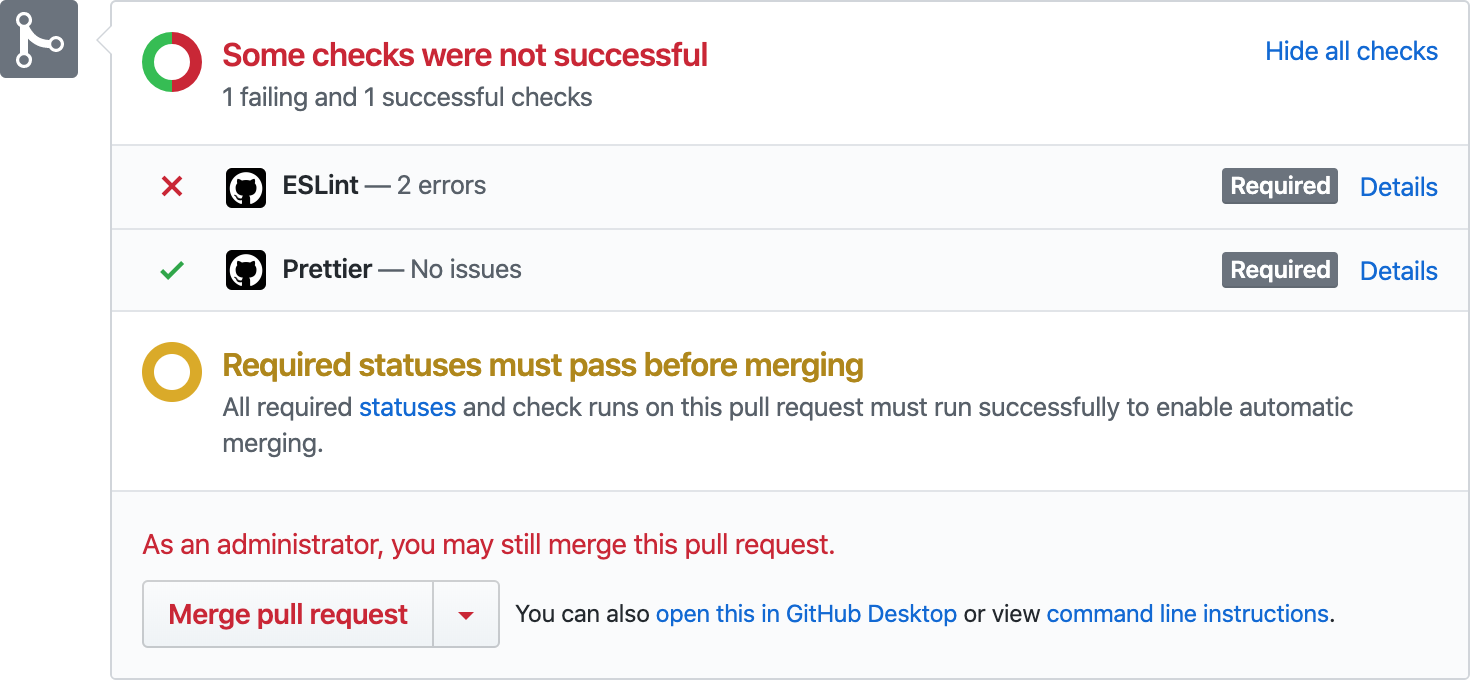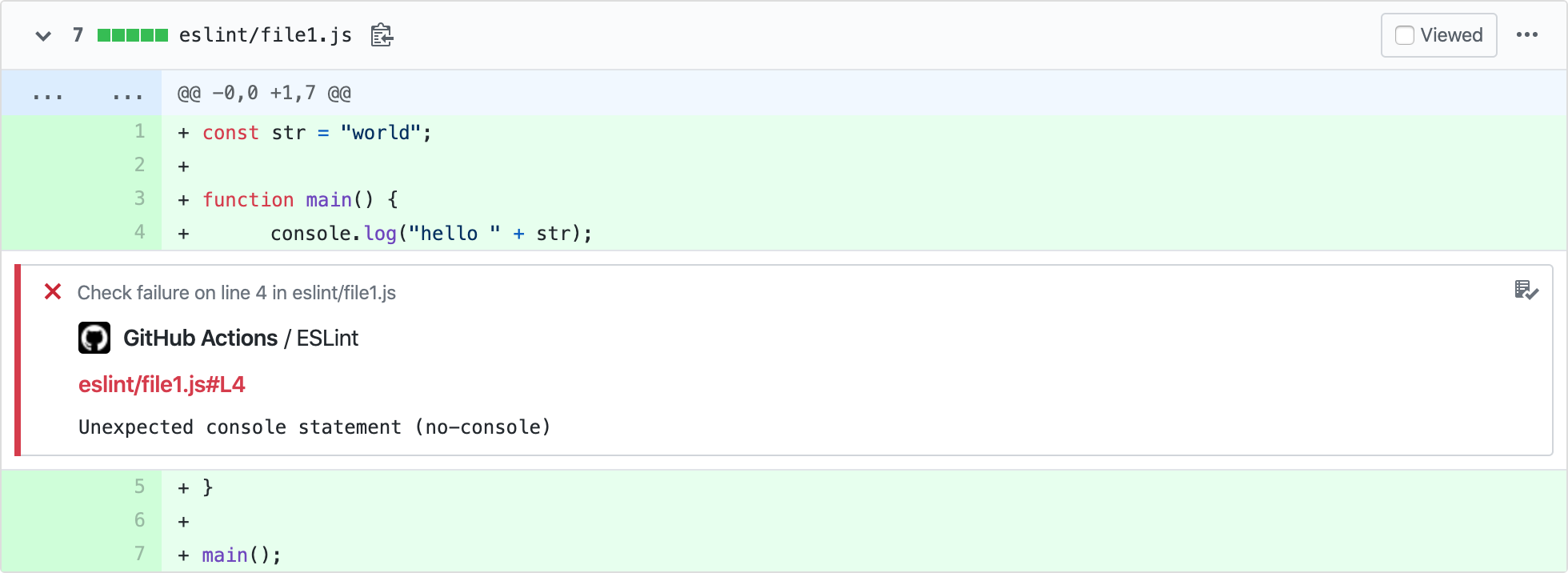- Shows linting errors on GitHub commits and PRs
- Allows auto-fixing issues
- Supports many linters and formatters
Note: The behavior of actions like this one is currently limited in the context of forks. See Limitations.
- CSS:
- Go:
- JavaScript:
- Python:
- Ruby:
- Swift:
- swift-format (official)
- SwiftFormat (by Nick Lockwood)
- SwiftLint
Create a new GitHub Actions workflow in your project, e.g. at .github/workflows/lint.yml. The content of the file should be in the following format:
name: Lint
on: push
jobs:
run-linters:
name: Run linters
runs-on: ubuntu-latest
steps:
- name: Check out Git repository
uses: actions/checkout@v2
# Install your linters here
- name: Run linters
uses: samuelmeuli/lint-action@v1
with:
github_token: ${{ secrets.github_token }}
# Enable your linters hereAll linters are disabled by default. To enable a linter, simply set the option with its name to true, e.g. eslint: true.
The action doesn't install the linters for you; you are responsible for installing them in your CI environment.
name: Lint
on: push
jobs:
run-linters:
name: Run linters
runs-on: ubuntu-latest
steps:
- name: Check out Git repository
uses: actions/checkout@v2
- name: Set up Node.js
uses: actions/setup-node@v1
with:
node-version: 12
# ESLint and Prettier must be in `package.json`
- name: Install Node.js dependencies
run: npm install
- name: Run linters
uses: samuelmeuli/lint-action@v1
with:
github_token: ${{ secrets.github_token }}
# Enable linters
eslint: true
prettier: truename: Lint
on: push
jobs:
run-linters:
name: Run linters
runs-on: ubuntu-latest
steps:
- name: Check out Git repository
uses: actions/checkout@v2
- name: Set up Python
uses: actions/setup-python@v1
with:
python-version: 3.8
- name: Install Python dependencies
run: pip install black flake8
- name: Run linters
uses: samuelmeuli/lint-action@v1
with:
github_token: ${{ secrets.github_token }}
# Enable linters
black: true
flake8: true[linter] can be one of black, eslint, flake8, gofmt, golint, mypy, prettier, rubocop, stylelint, swift_format_official, swift_format_lockwood, swiftlint and xo:
[linter]: Enables the linter in your repository. Default:false[linter]_args: Additional arguments to pass to the linter. Example:eslint_args: "--max-warnings 0"if ESLint checks should fail even if there are no errors and only warnings. Default:""[linter]_dir: Directory where the linting command should be run. Example:eslint_dir: server/if ESLint is installed in theserversubdirectory. Default: Repository root[linter]_extensions: Extensions of files to check with the linter. Example:eslint_extensions: js,tsto lint JavaScript and TypeScript files with ESLint. Default: Varies by linter, seeaction.yml[linter]_command_prefix: Command prefix to be run before the linter command. Default:"".
-
auto_fix: Whether linters should try to fix code style issues automatically. If some issues can be fixed, the action will commit and push the changes to the corresponding branch. Default:false -
git_name: Username for auto-fix commits. Default:"Lint Action" -
git_email: Email address for auto-fix commits. Default:"lint-action@samuelmeuli.com" -
commit_message: Template for auto-fix commit messages. The${linter}variable can be used to insert the name of the linter. Default:"Fix code style issues with ${linter}"
There are currently some limitations as to how this action (or any other action) can be used in the context of pull_request events from forks:
- The action doesn't have permission to push auto-fix changes to the fork. This is because the
pull_requestevent runs on the upstream repo, where thegithub_tokenis lacking permissions for the fork. Source - The action doesn't have permission to create annotations for commits on forks and can therefore not display linting errors. Source 1, source 2
For details and comments, please refer to #13.
Suggestions and contributions are always welcome! Please discuss larger changes via issue before submitting a pull request.
If you want to add support for an additional linter, please open an issue to discuss its inclusion in the project. Afterwards, you can follow these steps to add support for your linter:
- Clone the repository and install its dependencies with
yarn install. - Create a new class for the linter, e.g.
src/linters/my-linter.js. Have a look at the other files in that directory to see what functions the class needs to implement. - Import your class in the
src/linters/index.jsfile. - Provide a sample project for the linter under
test/linters/projects/my-linter/. It should be simple and contain a few linting errors which your tests will detect. - Provide the expected linting output for your sample project in a
test/linters/params/my-linter.jsfile. Import this file intest/linters/linters.test.js. You can run the tests withyarn test. - Update the
action.ymlfile with the options provided by the new linter. - Mention your linter in the
README.mdfile. - Update the test workflow file.
- Electron Builder Action – GitHub Action for building and releasing Electron apps
- Maven Publish Action – GitHub Action for automatically publishing Maven packages


